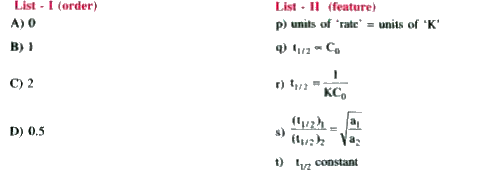The rate constant for a zero order reaction is 2×102 mol L−1sec−1 .If the concentration of the reactant after 25 sec is 0.5 M., the initial concentration must have beenSolution in Telugu
0.5 M
1.25 M
12.5 M
1.0 M
The correct Answer is:D
C0−Ct=K.t,(C0−0.5)=2×10−2×25,C0=0.5×0.5=1M
Topper's Solved these Questions
- CHEMICAL KINETICSBOOK - AAKASH SERIESCHAPTER - CHEMICAL KINETICSEXERCISE - LEVEL-II(LECTURE SHEET EXERCISE-II LINKED COMPREHENSION TYPE QUESTIONS)
9 Videos
- CHEMICAL KINETICSBOOK - AAKASH SERIESCHAPTER - CHEMICAL KINETICSEXERCISE - LEVEL-II(LECTURE SHEET EXERCISE-III MATCH THE FOLLOWING QUESTIONS)
3 Videos
- CHEMICAL KINETICSBOOK - AAKASH SERIESCHAPTER - CHEMICAL KINETICSEXERCISE - LEVEL-1 (EXERCISE -II ORDER, MOLECULARITY, HALF LIFE:)
34 Videos
- CHEMICAL KINETCSBOOK - AAKASH SERIESCHAPTER - CHEMICAL KINETCSEXERCISE - EXERCISE - 3.2
45 Videos
- CHEMICAL THERMODYNAMICSBOOK - AAKASH SERIESCHAPTER - CHEMICAL THERMODYNAMICSEXERCISE - Additional Practice Exercise
54 Videos
Similar Questions
A certain endothermic reaction: A→ Product, ΔH=+ve proceeds ina sequence of three elementary steps with the rate constant K1,K2 and K3 and each one having energy of activation E1,E2 and E3 respectively at 25∘C. The observed rate constannt for the reaction is equal to K3√K1K2.
A1,A2 and A3 are Arrhenius parameters respectively.
The observed energy of activation for the reaction is
View SolutionMatch the following columns

View SolutionSucrose decompose in acid solution into glucose and fructose according to the first order rate law, with t12=3.00 hours. What fraction of sample of sucrose remains after 8 hours ?
View SolutionDiscuss on the kinetic spontaneity of a chemical reaction. Is a slow reaction spontaneous? Why?
View SolutionWhich among the following is not an exact differential?
View SolutionThe rate constant for a zero order reaction is 2xx10^(-2) mol L^(-1) sec^(-1) . If the concentration of the reactant after 25 sec is 0.5 M , the initial concentration must have been:
View SolutionRate for a zero order reaction is 2xx10^(-2) mol L^(-1) s^(-1) . If the concentration of the reactant after 25s is 0.5M , the initial concentration must have been
View SolutionThe rate contant for zero order reaction is 3xx10^(-2) mol^(-1)L.sec^(-1) . After 25 sec. If the concentraition of reactant is 0.5 M them initial concentraition of the reactant is :-
View SolutionThe specific rate constant for a first order reaction is 1 times 10^–3 sec^–1 . If the initial concentration of the reactant is 0.1 mole per litre the rate (in mol l^-1 sec^-1 ) is:
View SolutionThe rate constant for a zero order reaction is 2×10−2molL−1sec−1. If the concentration of the reactant after 25sec is 0.5M, the initial concentration must have been:
View SolutionThe specific rate constant for a first order reaction is 1 times 10^–3 sec^–1 . If the initial concentration of the reactant is 0.1 mole/lt, the rate of reaction mol l^–1 sec^–1 is:
View SolutionThe specific rate constant for a first order reaction is 60xx10^(-4) sec^(-1) . If the initial concentration of the reactant is 0.01mol L^(-1) , the rate is
View SolutionThe rate constant for a zero order reaction is 2xx10^(-2) mol L^(-1)sec^(-1) . If the concentration of the reactant after 25 sec is 0.5M , the initial concentration must have been
View SolutionThe rate constant of zero order reaction is 2xx10^(-2) mole L /sec. If the concentration of the reactant after 25 sec is 0.5 M, the initial concentration is
View SolutionK for a zero order reaction 2×10−2molL−1sec−1 If the concentration of the reactant after 25 sec is 0.5 M, the initial concentration must have been:
View Solution
